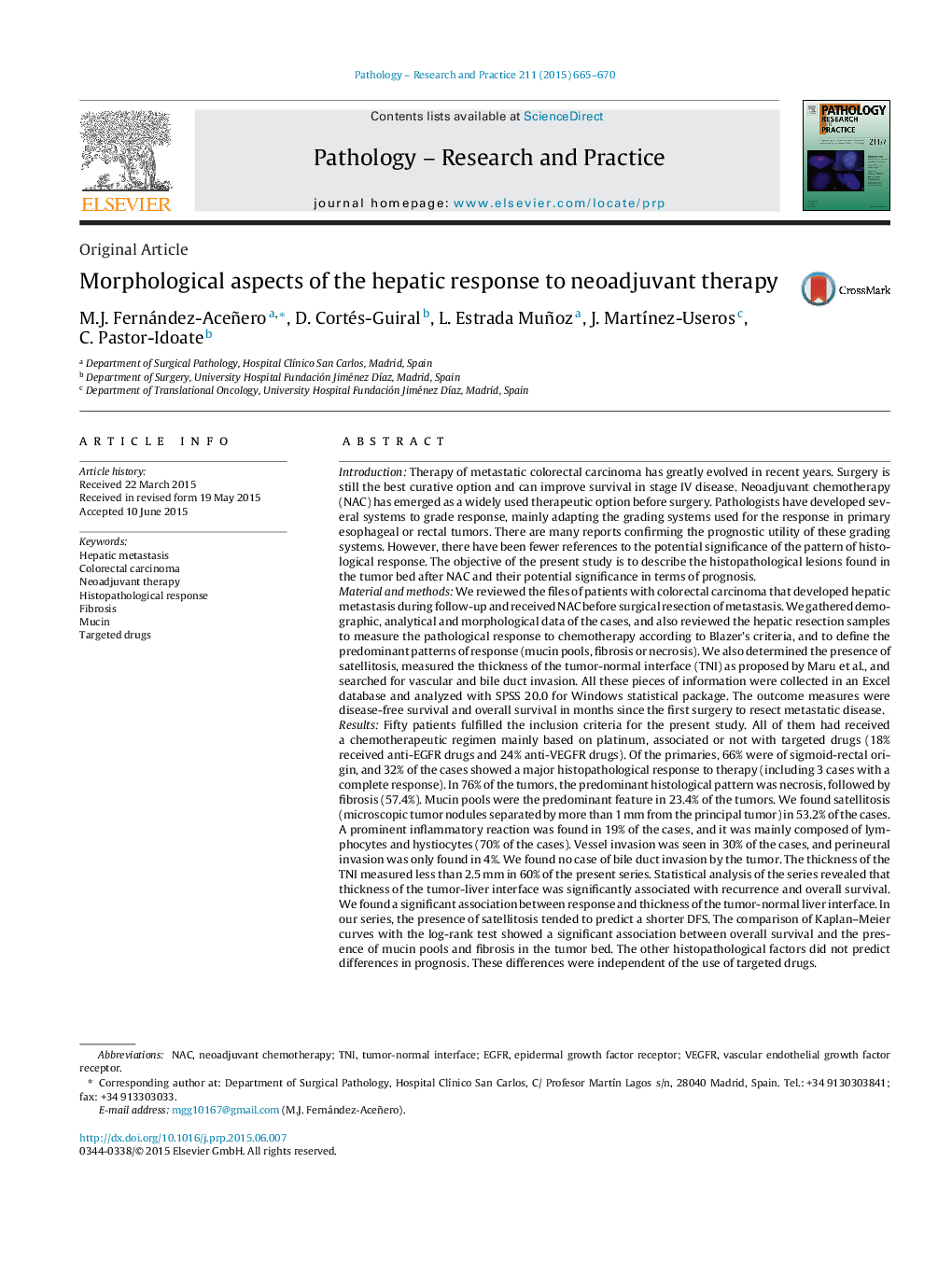| کد مقاله | کد نشریه | سال انتشار | مقاله انگلیسی | نسخه تمام متن |
|---|---|---|---|---|
| 2155261 | 1090390 | 2015 | 6 صفحه PDF | دانلود رایگان |
IntroductionTherapy of metastatic colorectal carcinoma has greatly evolved in recent years. Surgery is still the best curative option and can improve survival in stage IV disease. Neoadjuvant chemotherapy (NAC) has emerged as a widely used therapeutic option before surgery. Pathologists have developed several systems to grade response, mainly adapting the grading systems used for the response in primary esophageal or rectal tumors. There are many reports confirming the prognostic utility of these grading systems. However, there have been fewer references to the potential significance of the pattern of histological response. The objective of the present study is to describe the histopathological lesions found in the tumor bed after NAC and their potential significance in terms of prognosis.Material and methodsWe reviewed the files of patients with colorectal carcinoma that developed hepatic metastasis during follow-up and received NAC before surgical resection of metastasis. We gathered demographic, analytical and morphological data of the cases, and also reviewed the hepatic resection samples to measure the pathological response to chemotherapy according to Blazer's criteria, and to define the predominant patterns of response (mucin pools, fibrosis or necrosis). We also determined the presence of satellitosis, measured the thickness of the tumor-normal interface (TNI) as proposed by Maru et al., and searched for vascular and bile duct invasion. All these pieces of information were collected in an Excel database and analyzed with SPSS 20.0 for Windows statistical package. The outcome measures were disease-free survival and overall survival in months since the first surgery to resect metastatic disease.ResultsFifty patients fulfilled the inclusion criteria for the present study. All of them had received a chemotherapeutic regimen mainly based on platinum, associated or not with targeted drugs (18% received anti-EGFR drugs and 24% anti-VEGFR drugs). Of the primaries, 66% were of sigmoid-rectal origin, and 32% of the cases showed a major histopathological response to therapy (including 3 cases with a complete response). In 76% of the tumors, the predominant histological pattern was necrosis, followed by fibrosis (57.4%). Mucin pools were the predominant feature in 23.4% of the tumors. We found satellitosis (microscopic tumor nodules separated by more than 1 mm from the principal tumor) in 53.2% of the cases. A prominent inflammatory reaction was found in 19% of the cases, and it was mainly composed of lymphocytes and hystiocytes (70% of the cases). Vessel invasion was seen in 30% of the cases, and perineural invasion was only found in 4%. We found no case of bile duct invasion by the tumor. The thickness of the TNI measured less than 2.5 mm in 60% of the present series. Statistical analysis of the series revealed that thickness of the tumor-liver interface was significantly associated with recurrence and overall survival. We found a significant association between response and thickness of the tumor-normal liver interface. In our series, the presence of satellitosis tended to predict a shorter DFS. The comparison of Kaplan–Meier curves with the log-rank test showed a significant association between overall survival and the presence of mucin pools and fibrosis in the tumor bed. The other histopathological factors did not predict differences in prognosis. These differences were independent of the use of targeted drugs.DiscussionThe pathological reports of hepatic metastasis from colorectal carcinoma resected after NAC usually indicate only the number, the size and the response of the tumor cells to therapy, apart from the distance to the resection margin of the specimen. Few reports have analyzed the possible prognostic significance of the different kinds of histopathological responses. The results of the present study indicate that those tumors with extensive pools of mucin show a significantly worse prognosis as compared to tumors with less mucin secretion. Fibrosis indicates a better prognosis, except when desmoplasia is present. Our study further supports the prognostic significance of the thickness of the tumor-hepatic interface. We conclude that pathology reports should specify the kind of histopathological response to therapy, besides grading it, because this might add significant prognostic information.
Journal: Pathology - Research and Practice - Volume 211, Issue 9, September 2015, Pages 665–670
